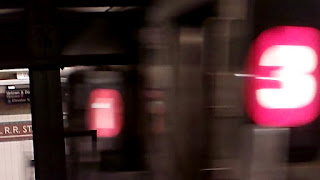My dad worked the four-to-midnight shift for most of his years at the big post office. He boarded the Number 1 train in the Bronx
for the fifty-or-so minute ride downtown. Unfortunately, his trip coincided
with the end of the school day. It was an inauspicious time to be an adult straphanger. Coming home
from school—after an unpleasant day on unpleasant transportation—I
encountered my father on many occasions dutifully navigating his way to the 231st Street subway
station. With a newspaper tucked under his arm and large paper bag—pre-plastic
supermarket issue—containing his supper, a piece of fruit, and a beer or two,
he never appeared overly thrilled to be going where he was going. The beers, by the way, were against the rules and
one could get “written up”—if caught in the act by an unsympathetic supervisor—for the transgression, which my father was at some point. In fact, more than a few of his tales
from the job frontier included postal employees who had smuggled in libations and their late-night antics.
Once upon a time I subscribed to both Time magazine
and Newsweek. I invariably received them in the mail week after week. Considering that they had to pass through
a junk mail division of a post office—with men and women not always one
hundred percent dedicated to the task at hand—I was amazed. And so it went. Time and Time magazine passes.
Nowadays, there are appreciably fewer pieces of bulk mail wending their way
through the U.S.P.S. Who would have thought it possible? Catalogs used to
clog our mailboxes. One order from Miles Kimball, L.L. Bean, or Sears would set
in motion a mail-order catalog avalanche—a multiplier effect with seemingly no
end in sight. But there was an end in sight. Technology saw to that.
I thought about such endings when I entered an uptown Number
1 train on my return trip home. There before me was a passenger perusing the Daily
News, which is rather slim these days. Not very long ago in the scheme of
things, subway riders reading newspapers was a commonplace sighting. It was the ideal diversion to pass the time. Burying one's head in a newspaper was, too, preferable to making eye contact with the huddled masses.
On his way to work, my dad—never fail—left the house with a newspaper.
And—when it existed—returned home with a late-night edition of the Daily News called the “Night Owl.” Many a morning in my youth, I sought out the
Night Owl—first thing—to see if my favorite team, the New York Mets, had won or lost a game
that I was unable to stay up for. The Night Owl rode off into the darkness of
night in 1981. Several years after that, my father bid adieu to the gloom of
night—his job at the big post
office—and retired.
Really, time waits for no man and no woman. My father’s postal employment began in the shadows of Penn Station when it was a magnificent specimen of architecture, although a shadow of what it once was. He was there when the powers-that-be permitted it to be completely demolished and rebuilt—to put it nicely—with none of its original grandeur and charm. What it became in short order—with Madison Square Garden as its crown jewel—was an unsightly and over-crowded mess. Contemporary politicians are trying to rectify the ghastly chaos that is. It won’t be easy and it will be very expensive. Life is a blur and then we die. And—when I accomplish the latter—Penn Station will look different again. Better? Well, that remains to be seen.
Really, time waits for no man and no woman. My father’s postal employment began in the shadows of Penn Station when it was a magnificent specimen of architecture, although a shadow of what it once was. He was there when the powers-that-be permitted it to be completely demolished and rebuilt—to put it nicely—with none of its original grandeur and charm. What it became in short order—with Madison Square Garden as its crown jewel—was an unsightly and over-crowded mess. Contemporary politicians are trying to rectify the ghastly chaos that is. It won’t be easy and it will be very expensive. Life is a blur and then we die. And—when I accomplish the latter—Penn Station will look different again. Better? Well, that remains to be seen.
(Photos from the
personal collection of Nicholas Nigro)





No comments:
Post a Comment
Note: Only a member of this blog may post a comment.